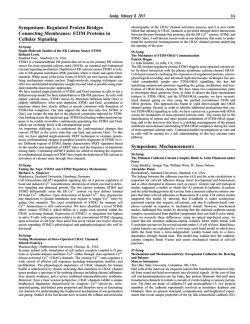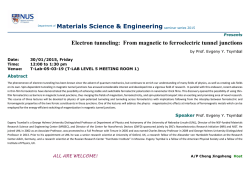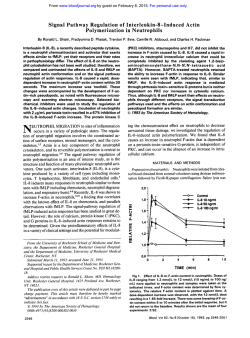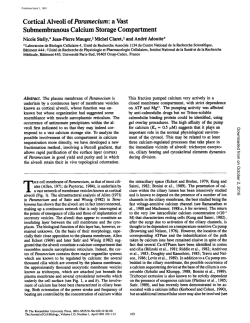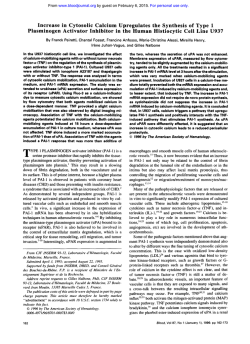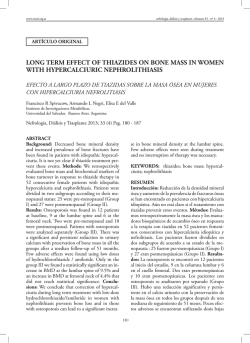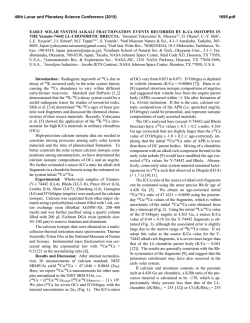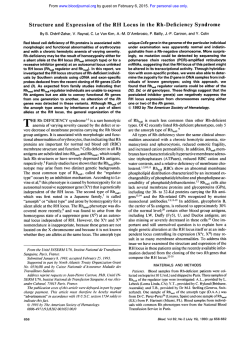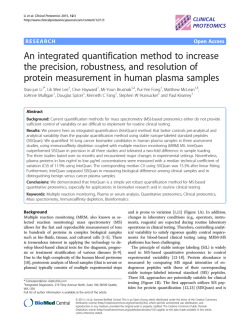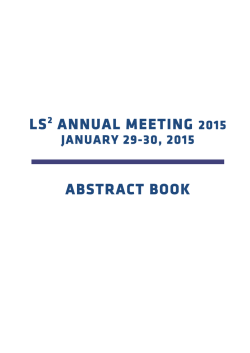
The Mechanics of STIM-ORAI Communication
Sunday, February 8, 2015 Symposium: Regulated Protein Bridges Connecting Membranes: STIM Proteins in Cellular Signaling 52-Symp Single-Molecule Studies of the ER Calcium Sensor STIM1 Richard Lewis. Stanford Univ., Stanford, CA, USA. STIM1 is a transmembrane ER protein that serves as the primary ER calcium sensor for store-operated calcium entry (SOCE), an essential and widespread calcium signaling mechanism. Depletion of ER calcium causes STIM1 to relocate to ER-plasma membrane (PM) junctions where it binds and opens Orai1 channels. While many of the basic events of SOCE are now known, the underlying mechanisms remain unclear. Single-molecule imaging techniques can offer new and detailed mechanistic insights beyond what is possible using standard ensemble macroscopic approaches. We have tracked single particles of STIM1 and Orai1 proteins in cells to test a diffusion-trap model for their redistribution to ER-PM junctions. In cells with replete calcium stores, STIM1 moves by Brownian diffusion while Orai1 is slightly subdiffusive. After store depletion, STIM1 and Orai1 accumulate at junctions where they slowly diffuse at speeds consistent with formation of STIM-Orai complexes. Our data support the idea that only free STIM1 or Orai1 can escape the trap due to the physical constraints imposed by STIMOrai binding across the junctional gap. STIM-Orai binding within junctions appears to be readily reversible, continuously generating free STIM1 and Orai1 which can exchange freely with extrajunctional pools. An important challenge is to understand the conformational changes that convert STIM1 to the active state that can bind and activate Orai1. To this end, we have applied single-molecule FRET techniques to examine spontaneous conformational changes in purified cytosolic fragments of STIM1 in vitro. Different regions of STIM1 display characteristic FRET signatures based on the number and amplitude of FRET states and the frequency of transitions among states. Continuing smFRET studies are aimed at tracking the sequence of conformational changes in STIM1 that couple the depletion of ER calcium to activation of calcium entry through Orai channels. 53-Symp Tuning the Taps: STIM1 and STIM2 Regulatory Mechanisms Barbara A. Niemeyer. Biophysics, Saarland University, Homburg, Germany. Cell homeostasis and IP3 dependent signaling rely on a precise regulation of basal and induced Ca2þ concentrations; alterations of which can lead to defective signaling and abnormal growth. The two known isoforms STIM1 and STIM2 differentially sense the ER Ca2þ content via their distinct luminal EF-hand Ca2þ affinities. Upon dissociation of bound Ca2þ, they oligomerize and translocate to plasma membrane near regions to trigger Ca2þ entry by gating Orai channels. The exact contribution of STIM2 for immune cell Ca2þ homeostasis is still controversial. We have identified a novel STIM2 splice variant, STIM2.1, which differs in a single exon inserted within the CRAC activating domain. Expression of STIM2.1 is ubiquitous but highest in naı¨ve T-cells with expression relative to the conventional STIM2 changing upon activation or cell type. How and if this novel variant can resolve discrepancies regarding STIM2’s physiological and pathophysiological role will be discussed. 54-Symp Gating Mechanisms of Store-Operated CRAC Channels Murali Prakriya. Pharmacology, Northwestern University, Chicago, IL, USA. In many animal cells, stimulation of cell surface receptors coupled to G proteins or tyrosine kinases mobilizes Ca2þ influx through store-operated Ca2þ release-activated Ca2þ (CRAC) channels. The ensuing Ca2þ entry regulates a wide variety of effector cell responses including transcription, motility, and proliferation. The physiological importance of CRAC channels for human health is underscored by studies indicating that mutations in CRAC channel genes produce a spectrum of devastating diseases including chronic inflammation, muscle weakness, and a severe combined immunodeficiency syndrome. Moreover, from a basic science perspective, CRAC channels exhibit a unique biophysical fingerprint characterized by exquisite Ca2þ-selectivity, storeoperated gating, and distinct pore properties and therefore serve as fascinating ion channels for understanding the biophysical mechanisms of ion permeation and gating. Studies in the last decade have revealed the cellular and molecular 11a choreography of the CRAC channel activation process, and it is now established that opening of CRAC channels is governed through direct interactions between the pore-forming Orai proteins, and the ER Ca2þ sensors, STIM1 and STIM2. Here, I will discuss recent work in our laboratory that seeks to understand the molecular rearrangements in the CRAC channel protein underlying the opening of the pore. 55-Symp The Mechanics of STIM-ORAI Communication Patrick Hogan. La Jolla Institute, La Jolla, CA, USA. The ER-resident regulatory protein STIM1 triggers store-operated calcium entry by direct interaction with the plasma membrane calcium channel ORAI1. Cell-based research combining the expression of engineered proteins, electrophysiological recording, and advanced light-microscopic techniques has provided considerable insight into STIM-ORAI signalling, but has left tantalizing unanswered questions regarding the gating, modulation, and inactivation of ORAI-family channels. We have taken two complementary paths to investigate these questions. First, in order to dissect the basic mechanisms intrinsic to STIM, ORAI, and the STIM-ORAI complex, we have reconstituted channel gating in vitro using the purified recombinant STIM and ORAI proteins. This approach has begun to yield direct insight into ORAI channel gating. Second, in order to identify additional mechanisms that control STIM-ORAI signalling in cells, we have carried out a genome-wide RNAi screen for modulators of store-operated calcium entry. The screen led to the identification of septins and other protein modulators of STIM-ORAI signalling, and to the discovery that there is a striking rearrangement of the plasma membrane microdomain surrounding STIM-ORAI complexes during the onset of store-operated calcium entry. Continued parallel investigations in vitro and in cells will be needed for a full understanding of this key calcium entry pathway. Symposium: Mechanosensors 56-Symp The Minimal Cadherin-Catenin Complex Binds to Actin Filaments under Force Craig Buckley, Jiongyi Tan, William Weis, W. James Nelson, Alexander Dunn. Biochemistry, Stanford University, Stanford, CA, USA. The linkage between the adherens junction (AJ) and the actin cytoskeleton is important for cell-cell adhesion during tissue development and homeostasis and is often disrupted in diseases such as cancer. Genetic and cell biological studies suggested a model in which the AJ proteins E-cadherin, b-catenin, and the actin binding protein aE-catenin form a minimal cadherin-catenin complex that links cell-cell adhesions to filamentous (F-) actin. Cell culture studies supported this model by showing that E-cadherin is under actomyosingenerated tension that requires aE-catenin, and that E-cadherin-based complexes remodel in response to mechanical stimuli. However, biochemical studies challenged this model by showing that the minimal cadherin-catenin complex reconstituted from purified components does not bind F-actin stably. Here we reconcile these differences: using an optical trap-based assay, we report that the minimal cadherin-catenin complex forms stable bonds with F-actin that can survive for several seconds under 5-15 pN of force. Bond dissociation kinetics are explained by a two-state catch bond model in which force shifts the bond from a force-independent, weakly bound state to a forcedependent, strongly bound state. This model may explain how the cadherincatenin complex binds F-actin and senses mechanical stimuli at cell-cell junctions. 57-Symp Mechanisms and Mechanosensitivity: Exceptional Cadherins for Hearing and Balance Marcos Sotomayor. The Ohio State University, Columbus, OH, USA. Hair cells of the inner ear are exquisite sensors that transform mechanical stimuli from sound and head movements into electrical signals. At the core of hair cell mechanotransduction are tip links, fine protein filaments that pull open transduction channels to initiate a cascade of events leading to sensory perception. Tip links are made of cadherin-23 and protocadherin-15, two atypical members of the cadherin superfamily involved in hereditary deafness and blindness. Here we present structural, computational, and biophysical experiments that reveal unique properties of the tip link extracellular cadherin (EC)
© Copyright 2026
